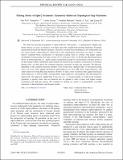| dc.contributor.author | Venderbos, Joern Willem Friedrich | |
| dc.contributor.author | Savary, Lucile | |
| dc.contributor.author | Ruhman, Yehonatan | |
| dc.contributor.author | Lee, Patrick A | |
| dc.contributor.author | Fu, Liang | |
| dc.date.accessioned | 2018-07-02T18:25:16Z | |
| dc.date.available | 2018-07-02T18:25:16Z | |
| dc.date.issued | 2018-02 | |
| dc.date.submitted | 2017-12 | |
| dc.identifier.issn | 2160-3308 | |
| dc.identifier.uri | http://hdl.handle.net/1721.1/116726 | |
| dc.description.abstract | We study the topological properties of superconductors with paired
j=3/2 quasiparticles. Higher spin Fermi surfaces can arise, for instance, in strongly spin-orbit coupled band-inverted semimetals. Examples include the Bi-based half-Heusler materials, which have recently been established as low-temperature and low-carrier density superconductors. Motivated by this experimental observation, we obtain a comprehensive symmetry-based classification of topological pairing states in systems with higher angular momentum Cooper pairing. Our study consists of two main parts. First, we develop the phenomenological theory of multicomponent (i.e., higher angular momentum) pairing by classifying the stationary points of the free energy within a Ginzburg-Landau framework. Based on the symmetry classification of stationary pairing states, we then derive the symmetry-imposed constraints on their gap structures. We find that, depending on the symmetry quantum numbers of the Cooper pairs, different types of topological pairing states can occur: fully gapped topological superconductors in class DIII, Dirac superconductors, and superconductors hosting Majorana fermions. Notably, we find a series of nematic fully gapped topological superconductors, as well as double- and triple-Dirac superconductors, with quadratic and cubic dispersion, respectively. Our approach, applied here to the case of j=3/2 Cooper pairing, is rooted in the symmetry properties of pairing states, and can therefore also be applied to other systems with higher angular momentum and high-spin pairing. We conclude by relating our results to experimentally accessible signatures in thermodynamic and dynamic probes. Subject Areas: Condensed Matter Physics, Superconductivity, Topological Insulators | en_US |
| dc.language.iso | en_US | |
| dc.publisher | American Physical Society | en_US |
| dc.relation.isversionof | http://dx.doi.org/10.1103/PhysRevX.8.011029 | en_US |
| dc.rights | Creative Commons Attribution 4.0 International License | en_US |
| dc.rights.uri | http://creativecommons.org/licenses/by/4.0/ | en_US |
| dc.source | APS | en_US |
| dc.title | Pairing States of Spin--3/2 Fermions: Symmetry-Enforced Topological Gap Functions | en_US |
| dc.type | Article | en_US |
| dc.identifier.citation | Venderbos, Jörn W. F., et al. “Pairing States of Spin- 3/2 Fermions: Symmetry-Enforced Topological Gap Functions.” Physical Review X, vol. 8, no. 1, Feb. 2018. | en_US |
| dc.contributor.department | Massachusetts Institute of Technology. Department of Physics | en_US |
| dc.contributor.mitauthor | Venderbos, Joern Willem Friedrich | |
| dc.contributor.mitauthor | Savary, Lucile | |
| dc.contributor.mitauthor | Ruhman, Yehonatan | |
| dc.contributor.mitauthor | Lee, Patrick A | |
| dc.contributor.mitauthor | Fu, Liang | |
| dc.relation.journal | Physical Review X | en_US |
| dc.eprint.version | Final published version | en_US |
| dc.type.uri | http://purl.org/eprint/type/JournalArticle | en_US |
| eprint.status | http://purl.org/eprint/status/PeerReviewed | en_US |
| dspace.orderedauthors | Venderbos, Jörn W. F.; Savary, Lucile; Ruhman, Jonathan; Lee, Patrick A.; Fu, Liang | en_US |
| dspace.embargo.terms | N | en_US |
| dc.identifier.orcid | https://orcid.org/0000-0002-0543-6298 | |
| dc.identifier.orcid | https://orcid.org/0000-0003-3706-8503 | |
| dc.identifier.orcid | https://orcid.org/0000-0001-7809-8157 | |
| dc.identifier.orcid | https://orcid.org/0000-0002-8803-1017 | |
| mit.license | PUBLISHER_CC | en_US |
